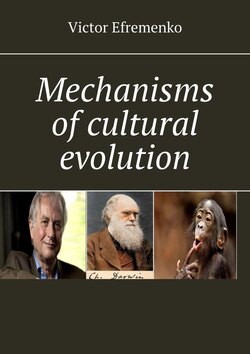Читать книгу Mechanisms of cultural evolution - Victor Efremenko - Страница 18
3. Cultural evolution of Homo sapiens
Differences in human evolution from other species
ОглавлениеSome people find it intolerable to realize that man and any kind of monkey have a common ancestor, that man is one of the species of the order of primates. I don’t understand this snobbery. But even among the human tribe, you can find representatives that seem terrible to every civilized person.
When you get to know a person, it is more correct to look not at his distant ancestors, but at what he is today. For a more detailed analysis, you should also pay attention to relatives.
In this section, we will show some of the differences between human evolution and the evolution of other mammalian species. According to the biological classification, it is customary to consider a person to be one of the species of the order of primates, therefore, he must obey the biological laws common to all, but this turns out to be not entirely true.
1. The basic model, which well describes the dynamics of animal population, is the logistic model proposed by the Belgian mathematician Verhulst back in 1838. The logistic curve, which is a solution to the Verhulstom equation, indicates a rapid increase in the number of the species at the beginning and a slowdown when it reaches the ceiling of the ecological niche. Thus, the capacity of an ecological niche is a systemic factor that determines the ceiling for population growth in a given habitat.
The logistic model reflects the dynamics of populations, the number of which, under any initial conditions, approaches with time to a certain stationary value.
Simply put, as long as there are resources for development, the number of this species grows rapidly, but resources are always limited, which causes limitation of the population size. Growth stops. The ecological niche is filled. A biological species is a passive consumer of existing resources.
Demography does not obey this law, although we are typical monkeys in morphology and mathematicians had to invent their own equations for humans that describe the demographic process.
On the models of population growth (http://www.keldysh.ru/papers/2005/prep13/prep2005_13.html)
This suggests that, under the guise of HS, someone has appeared whose numbers do not obey the general rule.
2. The ecological niche, which limits the distribution of any species, is expanded by man and is not a limiting parameter for him.
3. With an increase in the population size, the area occupied by it increases proportionally. So it was with HS. But for some time, people began to crowd into cities.
4. Natural selection is selection, as a rule, individual selection in populations. Different structures (state, private) appear in societies, and along with individual selection, there is also group selection, selection between social structures within states and between different states on the planet. In particular, the class struggle and other types of joint struggle of different social groups for some preferences is a manifestation of group selection.
These processes of group selection cannot be adequately described within the framework of socio-Darwinism, but only within the framework of sociobiology, because this is mental selection, not selection based on morphological properties. For biological systems, group selection is not characteristic, but for human societies it is important.
5. People have created constitutions, laws that guarantee them certain rights. In biological evolution, no one guarantees anyone any rights.
6. The speed of human social evolution is much higher than biological and is still increasing.
The listed changes (deviations from the usual biological evolutionary path) indicate that man has somehow evolved and is significantly different from Homo Sapiens, which appeared 160—180 thousand years ago. But these differences are not genetic. Differences in behavior are caused by functional changes in the states of neural networks, changes in thinking.
Functional changes in thinking are analogous to changes in the software environment in a computer, which give it different qualities.
These arguments are enough to admit that man is no longer an animal and cannot be viewed from a purely biological standpoint. It has evolved. But this happened not with the help of genes, as the evolution of species in biology takes place, but with the help of other replicators and a different mechanism of inheritance.
